|
ATV cargo ship
Finally on the pad: The Ariane-5 rocket with the ATV-1 Jules Verne spacecraft rolls last few meters on its movable platform before reaching its launch pad in Kourou, French Guiana, on March 7, 2008. Copyright © 2008 Anatoly Zak |
|||||||
| ORIGIN OF THE PROGRAM | ||||||||
|
Soon after its decision to participate in the US Space Station program, the European Space Agency, ESA, had ordered a study aimed at determining the design and capabilities of a specialized maneuverable space tug which would support the orbital outpost. Although the American Space Shuttle and the European Hermes reusable space planes were expected to deliver and return most of the space station supplies, an unmanned expendable vehicle seemed to be a better choice for the task of carrying some payloads or for disposing of trash. |
||||||||
| TECHNOLOGY | ||||||||
|
Slightly bigger than a London double decker bus, the 19-ton ATV vehicle consisted of a cargo module, including a pressurized section and a service module, carrying the avionics and propulsion section. The vehicle was capable of carrying up to 7.4 tons of payload to the ISS. |
||||||||
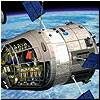 |
European Space Agency published several concepts for the follow-on versions of the ATV ship, including one equipped with a capsule capable of returning cargo to Earth. Sources within the European aerospace industry also said that ATV’s engineering experience could serve as a bridge toward a new-generation manned spacecraft, possibly developed in cooperation with Russia. |
|||||||
|
|
Launcher: Ariane-5 Specifically for the ATV program, European Space Agency, funded the development of a specialized version of the Ariane-5 rocket, designated Ariane-5ES. It was equipped with an EPS upper stage, developed by EADS Astrium and capable of multiple firings. A specialized adapter, known as SDM, was also introduced for ATV missions. |
|||||||
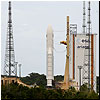 |
The Ariane-5 rocket carrying ATV would fly from its only existing launch facility in Kourou, French Guiana. Designated ELA-3, it was designed to handle a launch rate of eight to ten Ariane-5 launches per year at one month intervals. |
|||||||
| MISSION HISTORY | ||||||||
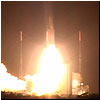 |
The launch of the Ariane-5 rocket carrying the first Automated Transfer Vehicle, ATV-1 Jules Verne, took place as scheduled during early hours of March 9, 2008, from the European spaceport in Kourou, French Guiana. |
|||||||
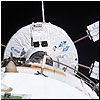 |
ATV-2 Johannes Kepler As of 2008, the second ATV vehicle was scheduled to fly in mid-2010. On Feb. 19, 2009, ESA officially dubbed the mission Johannes Kepler after the prolific German astronomer and mathematician. As of August 2009, the mission was expected on Nov. 30, 2010. On Oct. 1, 2010, Arianespace announced that the mission was delayed to Feb. 15, 2010. The 19,700-kilogram spacecraft was finally launched on Feb. 16, 2011, at 6:50 p.m. local time. The docking of the spacecraft with the ISS was scheduled for Feb. 24, 2011, at 15:45 GMT. The spacecraft did reach the station as planned. The vehicle undocked from ISS on June 21, 2011, at 14:46:33 GMT and conducted a dual deorbiting burn at 17:07 and 20:04 GMT, leading to a loss of contact at 20:41:39 GMT. |
|||||||
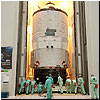 |
ATV-3 Edoardo Amaldi As of August 2009, the launch of the ATV-3 cargo ship to the International Space Station was expected at the end of 2011. Named Edoardo Amaldi, after Italian physicist and space flight pioneer, the cargo ship actually lifted off on March 23, 2012, at 1:34 a.m. local time in French Guiana. The ATV-3 carried 6.6 metric tons of cargo for the ISS. Its docking with the station took place as scheduled on March 28, at 22:33 GMT. ATV-3 was expected to remain at the station for nearly six months. It undocked from the station on Sept. 28, 2012, at 5:44 p.m. EDT and was deorbited on Oct. 3, 2012, burning up at 01:30 GMT (03:30 CEST). |
|||||||
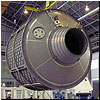 |
ATV-4 Albert Einstein As of November 2011, the launch of ATV-4 cargo ship named after Albert Einstein was scheduled for the beginning of 2013. It was to be deorbited in August-September of the same year. During the final stage of the flight, ESA planned to organize a fire onboard and to watch its spread onboard shortly before the reentry of the vehicle. The ship arrived to Kourou on Sept. 19, 2012, with its launch scheduled for April 2013, however it had to be delayed until June 5, 2013, at 6:52:11 p.m. local time. The 20,235-kilogram vehicle became the heaviest European spacecraft. The spacecraft docked at the station on June 15 and was scheduled to remain there until October 28, 2013. Due to fungus contamination indications, the hatch into the spacecraft was opened with a 24-hour delay on June 18. The spacecraft undocked from the station at 4:55 a.m. EDT on October 28 for a scheduled reentry on Nov. 2, 2013. |
|||||||
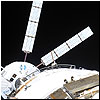 |
ATV-5 Georges Lemaître In February 2012, ESA announced that the 5th ATV ship would be named after Belgian scientist Georges Lemaître, father of the Big Bang theory. As of September 2012, the spacecraft was expected to fly in April 2014 and become the last vehicle in a series. The ship was delivered to French Guiana at the end of October 2013. The ATV-5 was successfully launched into orbit from Kourou on July 29, 2014, at 20:47:45 local time and arrived at the ISS on Aug. 12, 2014. The spacecraft undocked from the ISS on Feb. 14, 2015, and reentered on Feb. 15, 2015. |
|||||||